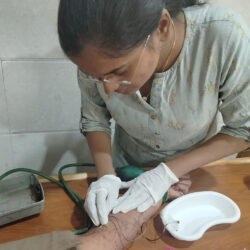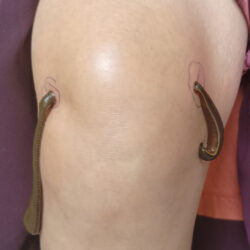PANCHAKARMA
The function of Panchakarma is to maintain the balance of the doshas, promote their reduction, pacify aggravated doshas, and correct advanced dosha imbalances.
– Sushruta
Panchakarma is a classic traditional Ayurvedic detox. It is also the most radical. The term Panchakarma means “five actions.” In Ayurveda, these five processes ensure the elimination of ama (undigested food) and pathogens from the body. Some also use the term body and mind detoxification therapy.
The objective of Panchakarma is to ensure that our body’s vital energy – “Prana” flows freely and purifies all seven dhatus. At the same time, all three doshas are also brought back into balance. This improves the individual’s well-being, as the body is brought to a natural state, to homeostasis. It also helps defend against many other imbalances in the body.
The five main processes of Panchakarma eliminate ama from the body (ama is undigested metabolic waste) and restore health to the seven dhatus – tissues:
- Rasa – lymph or plasma
- Rakta – blood or blood serum
- Mamsa – muscles or muscle tissue
- Meda – adipose tissue
- Asthi – bones and teeth or bone tissue
- Majja – bone marrow and nerves
- Shukra- reproductive organs
According to the Charaka Samhita, the body uses three routes to eliminate waste and toxins: the mouth, the anus, and the nose. The three doshas (vata, pitta, kapha) act as a vehicle that carries toxins up, down, or peripherally. “Dosha Gati” moves impurities from deep structures through these three openings. They are also excreted through the skin. The healing power of Panchakarma lies in its ability to stimulate the natural movement of the doshas to eliminate amatoxins. (up, down and peripheral)
SHAMANA
“Shamana” or palliative therapy for which an individual may opt cannot remedy this. On the other hand, Panchakarma permanently eliminates the cause because it removes accumulated toxins that have become deeply rooted in some tissue or organ. In addition, it restores the function of a particular tissue – the dhatu. It stabilizes digestion and dispels the possibility of future diseases associated with vata, pitta, and kapha disorders, where toxins accumulate.
PREPARATION FOR PANCHAKARMA – PURVAKARMA
Before Panchakarma, it is necessary to perform Purvakarma – preliminary preparation. There are two procedures called “Shenana” – oleation with herbal oils and “Svedana” – a steam bath; it can also be a sauna in a steam bath. Without proper preparation, these treatments would only remove the ama in the digestive tract and have little or no effect on the toxins deep in other tissues and organs. For example, castor oil would only remove the toxins associated with an increased pitta dosha.
Why isn’t everything removed? It is associated with heavy and sticky ama quality. Once it gets stuck in the deeper structures, it stubbornly anchors there.
Next comes the preparation for the two most important procedures. On “Vamana” and “Virechana”. When the body is adequately prepared, toxins are eliminated. The third most crucial procedure is “Vasti” or “Basti” – a medical enema that an individual can perform under supervision at home. Two more procedures are required, “Nasya” and “Raktamoksana.”
THE FIVE PROCESSES OF PANCHAKARMA
1. NASAYA, or “Shirovirechana,” is a procedure used to assist Vamana in removing ama and excess phlegm from the Kapha region. From the throat, nose, sinuses, and other organs in the head and neck area. Nasaya is the introduction of herbal medicinal agents and oils into the nose. This process stimulates secretion that helps remove the ama from the area. The primary effect of the treatment is to improve the connection between the senses and the organs of perception by opening the channels of the “Srotas” through which sensory information flows. The nostrils are a direct “channel” to the brain. Applying oils and herbs in the nostrils helps with chronic sinusitis, headaches, throat diseases, inflammation of other parts of the mucous membrane (catarrh), problems with the voice (vocal cords), and eye diseases. Breathing becomes clear and unhindered. The ability to smell is also improved. Nasya is called peripheral secretion.
2. VAMANA takes place in the upper body or kapha region and governs the upward movement of the doshas. Remove ama – accumulated toxins in this area. Kapha – related toxins are primarily, but not exclusively, eliminated through the upper body. Dosha action pulls kapha – related toxins into the stomach structure, condensing into a denser tissue – mucus. Here, kaphic ama naturally accumulates and is expelled by Vamana or therapeutic emesis. The oral cavity offers the easiest and most direct way to drain this ama. This process is called upward movement.
3. VIRECHANA works on pitta dosha. This is the part of the body whose main organs are the small intestine, stomach, liver, and blood. The liver is a sub-dosha of pitta, which otherwise has a primary place in the small intestine. Virechana cleanses the pitta zone and excess ama of pitta-related toxins that naturally accumulate there. This process is called downward movement and is done with herbal laxatives. Virechana is the best remedy for liver problems, gastrointestinal disorders, infections, and all dermatological imbalances related to the skin: eczema, allergies, and various dermatitis. Virechana is an intensive procedure and is not suitable for pregnant women, people with ulcerative colitis, and frail and elderly individuals.
4. VASTI, also known as BASTI, cleanses the area of the Vata dosha, the primary site of which is the large intestine. Ama associated with Vata is excreted through the rectum due to the proximity and accessibility of these organs. Vasti, or medicinal medicinal enema, is the introduction of medicinal herbal preparations into the large intestine through the anus. It stimulates the elimination of ama associated with vata dosha. The best known are “Nirooha Vasti” and “Anuvasana Vasti.” Traditional Pančarakma knows many more of them. For example, Kala Vasti, Karma Vasti, Yoga Vasti, etc. For each imbalance, a different enema is prepared, made of herbal preparations, pastes, oils, and healing decoctions – teas made from precisely defined and prescribed herbs. Vasti is recommended for problems with constipation, spleen, colic, and the formation or removal of kidney and gallstones. This process is called downward movement.
5. RAKTAMOKSANA is the last of the five elimination procedures. It removes pitta-related toxins from the blood. Raktamokshana is derived from the name “Rakta,” which means blood, and “Mokshana,” which means liberation. Traditional Ayurveda also uses leeches. They are used to remove poisoned peripheral blood, for example, varicose veins, joint pain, calcification, etc. This procedure literally releases impure (poisoned) blood from the peripheral system, relieves pain in the knees and joints, and is also used for psoriasis and some other imbalances.
Ractamoxana can also be administered by taking venous blood, but “Leeches” have much greater healing power. Scientists have discovered more than 120 enzymes in their saliva that have an anti-inflammatory effect, relieve pain, increase blood viscosity, have antibiotics effect, etc. This process is also called peripheral elimination of toxins. In the West, the procedure is known as hirudotherapy.


FOR PANCHAKARMA, YOU NEED TIME, PATIENCE AND WILL
These are the five procedures that constitute the main cleansing treatments of Panchakarma. When choosing this method of detoxification, you need to take your time. It usually takes twenty-one days or more. It depends on the imbalance, body toxicity, age, gender, weight, height, and psychophysical fitness of the individual. All these affect the length of the Panchakarma. Each protocol is different, and we adapt it for each individual. This does not mean that we do not eat or fast during this time. A specific diet is prescribed that must be followed.
If we decide on traditional Panchakarma, it makes sense to perform all five protocols; otherwise, the dhatus – tissues and organs, are not cleaned in detail, and the cleaning is incomplete.
THE SCIENCE OF LEECHES
- The best-known substance in leech saliva is hirudin, which comprises 65 amino acid molecules. When hirudin binds to platelets, a passive compound is formed. When platelets bind with other substances in the blood, they form solid polymers that can clog vessels and cause blood flow to stop. Platelets are essential for homeostasis as they repair blood vessels. When these are damaged, platelets are extremely dangerous, especially when larger polymers end up in the blood, as they can cause hypoxia, apoxia, or infarction.
- The second most important substance is kaline, which prevents blood clotting by blocking collagen binding with the help of the von Willebrand factor.
- Destabilase causes rapid dissolution of blood clots, which helps to restore blood circulation.
- Bdellins are anti-inflammatory and reduce tissue swelling.
- Hyaluronidase increases viscosity and has antibiotic effects. Its dispersion factor allows other substances from the leech’s saliva to penetrate deeper into the tissues.
- Egklins are a group of proteins with anti-inflammatory effects.
- Histamine-like substances dilate blood vessels and enable better blood circulation in the “bite” area.
- Anesthetics have an analgesic effect. The therapy is painless, and the anesthetic substances work long after the treatment.
- Baskova I.P. discovered with staff at Moscow State University that at least three substances from leech saliva have neurostimulatory properties: destabilase, bdelastasin, and bdellin.




